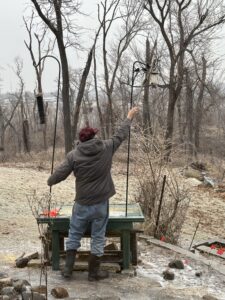
Frosted glass!
The world around Winding Pathways changed overnight. On December 14, 2024, we awoke to an ice-glazed world. We know that hurricanes, tornadoes, and derechos cause widespread havoc. Ice storms present their own perils to trees, people, and wild and domestic animals.
After lighting our woodstove, we pulled traction devices on our boots, grabbed trekking poles, and ventured outside just long enough to check for damage, gather eggs, and fill bird feeders.
Checking for Damage
Ice crystals sparkled and ice sheets reflected morning’s light in unusual ways as we carefully picked our way around the yard. Fortunately, we found no downed tree limbs and our chickens were tucked safely inside their coop. Wild birds had no choice. We filled all our feeders, sprinkled seeds on the ground, and scattered sand. Some we tossed on walkways to provide traction for us and a few scoops went amid the birdseed under our feeder. Birds need grit for digestion and it’s hard to find when the world is icy.
Helping the Birds
Many winter birds feed on frozen insects and spiders tucked into the crevices of tree bark. Others scratch through leaves to find seeds and bugs. With trees and the ground sheeted in ice, pickings were slim for animals that must eat an enormous amount of food daily to maintain a body heat of around 106 degrees.
It’s no wonder that cardinals, juncos, nuthatches, blue jays, chickadees, and the five species of woodpeckers in Iowa crowded our feeder and the ground underneath it on that icy morning. Starlings and house (English) sparrows soon showed up.
The overnight ice storm was not so thick that the tiny birds got trapped under the flap of bark where they often rest in storms. They were able to break out and get to the feeder before other birds arrived.
- Ice was so thick Rich hit with a pole to loosen it.
- Birds came early.
Turkeys Arrive

Wind ruffling back feathers.
We wondered when the gang of turkeys would show up and whether they weathered the night in the tops of the swaying and ice-encrusted trees. Late morning “Louie the Lonely Turkey” carefully picked his way across the frozen grass. What a surprise when he hopped up on the top of the sheet of ice on the platform feeder! He shot off the other end and, doing a pirouette like Sam Gribley in My Side of the Mountain, thumped down quite flummoxed when he stepped onto the ice after an ice storm. Louie gingerly climbed back up onto the platform feeder. And, we had our answer as to where he had slept. One side of his feathers and beard were crusted with ice. He had endured a cold night swaying in the tops of the tree as usual. The others haven’t shown up yet, so Louie feasted on the corn and sunflower seeds.
Deer Stayed Put
One backyard animal was initially absent. Often deer visit at night or early each morning but the icy glaze covers their food and makes walking treacherous. Unlike birds, deer put in a thick layer of fat each fall. During storms, they find a sheltered spot and “hole up”. They can sit still for several days without feeding to ride out a storm. A few did finally show up, realized the table goodies were again covered with ice from the day’s rain turned to ice, and left discouraged.
Squirrels Tried to Forage
Squirrels didn’t fare too well foraging and seemed to hole up in their tree holes or nests made of clumps of leaves in the tree tops. The previous night must have been quite the ride for them as well as the turkeys with the trees swaying and ice cracking on limbs.
Prairie Grasses Haven for Small Animals In Ice Storms
The prairie grasses on the knoll bent over with ice formed small enclosures where our resident cottontail took refuge. Deer tracks crossed the Harmony Phoenix Labyrinth as they wandered in the night.
- Contrast in color and texture.
- Birches bending under the weight. of the ice storms
Robert Frost had it right in his poem, Birches, “When I see birches bend to left and right, Across the lines of straighter darker trees, I like to think some boy’s been swinging them. But swinging doesn’t bend them down to stay. As ice storms do.”
The ice will melt as temperatures rise. Until it does, we’ll walk cautiously to reduce the odds of falling and keep our feeders well-stocked with seeds and grit.





